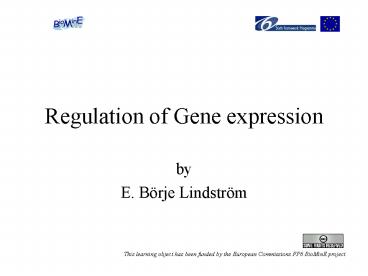Regulation of Gene expression - PowerPoint PPT Presentation
1 / 20
Title:
Regulation of Gene expression
Description:
This learning object has been funded by the European Commissions FP6 BioMinE project ... gene lacZ : b-galactosidase splits lactose into glycose galactose ... – PowerPoint PPT presentation
Number of Views:47
Avg rating:3.0/5.0
Title: Regulation of Gene expression
1
Regulation of Gene expression
- by
- E. Börje Lindström
This learning object has been funded by the
European Commissions FP6 BioMinE project
2
Introduction
- Biosynthetic reactions consume energy
? Sophisticated control mechanisms in bacteria
- Available energy is limited in Nature
? Production of as much cell material per energy
as possible
- The environment is important
- the nutrient in the medium is used first
- rapid and drastic changes in the nutrients ?
- reversible control reactions needed
- Two types of model systems
- Biosynthetic - Catabolic
3
Biosynthetic reactions
Tryptophan is chosen as a model system
- Tryptophan is an essential amino acid
- Tryptophan is missing in some plant proteins ?
- of industrial importance
- The bacterial cells are controlling the
biosynthesis of tryptophan in three ways
- feedback inhibition
- end product repression
- attenuation
4
Biosynthetic reactions, cont.
- Feedback inhibition
- The biosynthesis of tryptophan occurs in
several steps
E5
E4
E3
E2
E1
Chorismate glutamine ? antranilic acid ? B ? C
? D ? tryptophan
Mechanism
- - enzyme E1 (the first enzyme) is an allosteric
protein with - - a binding site for for the substrate
- a binding site for the effectors (inhibitor
try)
- E1 try ? E1-try-complex that is inactive
- the complete biosynthesis of try is stopped
5
Biosynthetic reactions, cont.
- End product repression (EPR)
- In spite of end product inhibition ?
- loss of energy due to enzymes E2-E5 are still
synthesized
- another regulation is needed
- end product repression
6
Biosynthetic reactions, cont.
Mechanism
P promoter O operator att attenuator
E1 E5 structural genes for the enzymes E1-E5.
- RNA polymerase binds to P
? Initiation of mRNA synthesis
- The repressor is an allosteric protein
- - inactive without tryptophan (does not bind to
the operator)
- tryptophan acts as co-repressor
- binds to the repressor
- makes the repressor active
? Blocks the RNA polymerase movement
- The repressor binds to O
7
Biosynthetic reactions, cont.
- Attenuator region
- barrier for the RNA polymerase
1) try ? the polymerase removed from the DNA
2) - try ? the polymerase continues into the
structural genes
- EPR inhibits all enzymes in tryptophan
biosynthesis - ? save energy
- however, a slow total inhibition does not
effect already existing enzymes - high specificity only the tryptophan operon is
effected
8
Biosynthetic reactions, cont.
9
Biosynthetic reactions, cont.
10
Biosynthetic reactions, cont.
11
Biosynthetic reactions, cont.
12
Catabolic reactions
- Catabolic systems are inducible
- The inducer is the available carbon/energy
source
- Model system lactose operon in E. coli
- Where
- gene R repressor protein active without the
inducer - ? blocks mRNA polymerase
- gene lacZ b-galactosidase splits lactose
into glycose galactose - gene lacY permease transport lactose into the
cell - no attenuator sequence in catabolic systems
13
Catabolic reactions, cont.
- Mechanism
lactose
- transported into the cell ? transformed into
allo-lactose (inducer) - allo-lactose repressor ? allo-lactose-represso
r- complex ? inactive - RNA polymerase starts transcription of lactose
operon - ? b-galactosidase is produced ? break down of
lactose
- lactose
- allo-lactose-repressor- complex disintegrate
- the repressor binds to O and blocks further
transcription of the operon
14
Catabolic reactions, cont.
15
Catabolic reactions, cont.
16
Catabolic repression (glucose-effect)
- Works in bacteria and other prokaryotes (here in
E. Coli K12)
- Diauxi
- growth on two energy sources glucose lactose
? - two-step growth curve
Growth on lactose
lactose
Growth on glucose
glucose
17
Catabolic repression (glucose-effect)
- Mechanism
- cAMP an important substance
- required for initiation of transcription of many
inducible systems - global regulation
- glucose present ? cAMP ? (decreases)
- CAP (katabolite activator protein) an
allosteric protein
- cAMP-CAP-complex binds to the promoter ?
promotes transcription
- production of b-galactosidase ?
- 1) lactose present
- 2) cAMP-CAP-complex present
18
Catabolic repression (glucose-effect), cont.
- glucose
- no cAMP-CAP-complex ?
- no transcription of lactose operon
- no b-galactosidase production
- - glucose
- cAMP-CAP-complex present ?
- transcription of lactose operon
- b-galactosidase production
- brake down of lactose
19
Catabolic repression (glucose-effect), cont.
- Conclusions
- Katabolite repression a very useful function
in bacteria - forces the bacteria to use the best energy
source first
20
Other types of Regulations
- Constitutive systems
- no regulation
- always present
- Enzymes that are needed during all types of
growth - e.g. those involved in glycolysis
- mRNA
- Unstable
- half-life 2 min ? sub-units
- ? new mRNA
- polycistronic mRNA
- one operator for several genes
- monocistronic mRNA
- one operator per gene (in eukaryotes)































